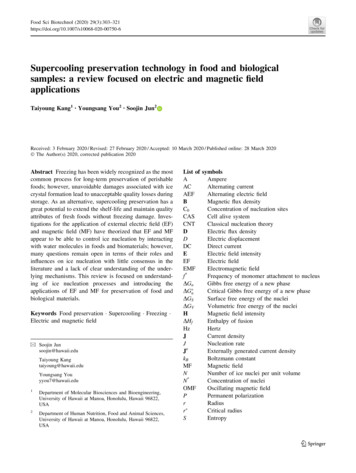
Transcription
WHY STAGE YOUR LIMBPRESERVATION SURGERIES?Mario Ponticello DPM FACFAS FAPWCAChief, Limb Preservation ServiceMadigan Army Medical CenterTacoma WAPNECMay 2019
DISCLOSURES No financial disclosures The views expressed herein are my views and do not reflectthe official policy of the Department of the Army, theDepartment of Defense or the U.S. Government
OBJECTIVES What doesstaged surgeryentail? Discuss literaturesupport for astaged surgicalapproach
CAPOBIANCO, STAPLETON ANDZGONIS. OCT 2010“Limb salvage among the diabeticpopulation, when feasible, canimprove function with fewer ionotropiccardiac effects than a major limbamputation.”
DOWHATYOUKNOW?
STAGED SURGERY Infection control Vascular assessment Reconstructive surgery
INFECTIONCONTROL Infection control aids inmedical stabilization Focus on the Here andNow, not the What willBe Thoroughexamination of allinvolved tissues Resection of ALLinfected soft tissueand bone
After 3 days of packingDebridement Completion
VASCULAR ASSESSMENT Preoperative assessment Palpation of pulses Bedside doppler exam Intraoperative assessment Gross tissue bleeding Fluorescent angiography Postoperative assessment ABI/TBIVascularSurgeon Consult
WHAT ELSE? Medical Glucose control/Comorbiditymanagement Antibiotic administration Discharge planning Surgical Serial debridements Bandage changes Edema management Immobilization Offloading
SOFT TISSUE RECONSTRUCTIONNegative PressureWound Therapy
OSSEOUSRECONSTRUCTION
COMBINED RECONSTRUCTION
LITERATURE SUPPORT FOR STAGEDSURGERY Silva et al., Annals of Vascular Surgery (2018) One-stage amputations vs staged amputations Retrospective N 185 pts with critical limb ischemia (207 amputations) 106 one-stage 101 staged Staged amputations had higher success rate, lowerperioperative mortality rate, lower 30 day mortality rate The level of amputation was higher using the one-stagemethod
LITERATURE SUPPORT FOR STAGEDSURGERYBerceli et al.(2006) Open amputations vsStaged amputationsvs One-staged closedamputations Staged closure healedfaster withoutnegatively impactingthe risk of major limbamputationFisher et al.(1988)Altindas et al.(2011) One-stage vs Twostage amputations One-stageamputations hadmore woundcomplications Staged transtibialamputations Risk of unnecessarytissue sacrifice andfailure rate of thesecondary transtibialamputation wasreduced
OSTEOMYELITIS TREATMENT FAILURE Treatment failure of 20%-35% Barshes et al.(2016) 184 cases of foot osteomyelitis with 23.4% were repeat offenders339 organisms were identified in total 2.4 organisms per bone cultureE coli and Pseudomonus aeruginosa had increased treatment failuresMRSA was not associated with higher rates of treatment failureStaged closure had lower rate of failure (p 0.01)Severe PAD,PAD that was incompletely assessed, or occluded bypass grafts hadhigher rates of treatment failure
CONCLUSIONS Staged surgery for the infecteddiabetic foot has been shown to be asafe option that reduces risk forfurther return to the OR Vascular evaluation is key Proper source control is vital to thesuccess of the process
LITERATURE CITED1. Capobianco CM,Stapleton JJ, and T Zgonis. Surgical Management ofDiabetic Foot and Ankle Infections. 2010. Foot and Ankle Specialist;3(5):223-230.2. Silva LR et al. Results of One-Stage or Staged Amputations of Lower LimbsConsequent to Critical Limb Ischemia and Infection. 2018. Annals of VascSurg;46:218-225.3. Barshes NR et al. Treatment Failure and Leg Amputation among Patientswith Foot Osteomyelitis. 2016. Int J Lower Extremity Wounds;15(4):303-312.
Mario Ponticello DPM FACFAS FAPWCA Chief, Limb Preservation Service Madigan Army Medical Center Tacoma WA PNEC May 2019. DISCLOSURES No financial disclosures The views expressed herein are my views and do not refle











